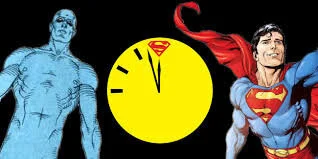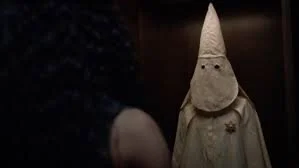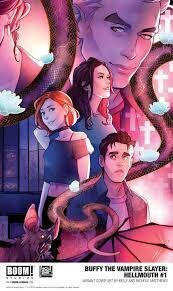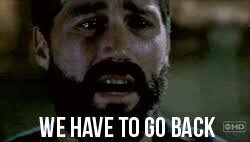Watchmen Episode 2: Remix and Match
Pale Horse, Easy Rider
I just figured something out.
Not about the secrets of HBO’s Watchmen; Episode 2 confirmed my hunch that this is not one of those mystery stories that feels the need to “play fair” with the audience. I seriously doubt that when the season is over, I will look back at the first two episodes and think, “Of course! It was all right there in the beginning! I just couldn’t see it!” And that’s fine. [1]
But Episode 2 did get me thinking about Damon Lindelof’s declaration that his Watchmen would not be a sequel, but a “remix.” At the time, I simply thought that was a clever way of distinguishing between his ambitions for his new prestige drama and the superfluity of Geoff Johns’ never-ending sequel, Doomsday Clock. [2] Now I’ve come to realize how important the idea of the remix is not just to the HBO series, but to Lindelof’s work writ large.
DOOMSDAY CLOCK IS RUNNING LATE, AND I’M STRANGELY OK WITH THAT
What, after all, is a remix? The term comes to us from music, when tracks are added or subtracted to an existing song to create a new version. People of my generation (i.e., soon-to-be-old-people) may recall Suzanne Vega’s 1980s a cappella Tom’s Diner, a minor folk hit that was turned into a dance sensation when the British group DNA grafters her vocals onto a neo-soul/hip hop beat. The salient elements from the original remain, but the the result is more than the sum of its constituent parts.
“Martial Feats of Comanche Horsemanship” (Watchmen Episode 2) may seem to be intentionally convoluted on the level of plot, but it simultaneously brings clarity to the “remix” question. The first episode already had numerous echoes of the first issue of Watchmen (the murder, the stained badge), but the second makes the parallels unmistakeable. Here are just a few:
The present-day funeral facilitating flashbacks to key moments in the past;
Scene-to-scene transitions based on a homology of shapes (the horses in the painting and the horse Veidt is riding; Veidt’s watch and Will’s alarm clock are mirror images of each other, five before twelve and five after twelve);
The increased focus on Hooded Justice (who is discussed at some length in the second issue's excerpt from Under the Hood);
Angela finding a closet behind Judd’s closet, just like Rorschach did in Eddie Blake’s apartment;
Eddie Blake was hiding a Comedian costume; Judd had full KKK regalia stashed away;
The “White Night” flashback, with masked racist vigilantes slaughtering cops, is the mirror image of the “Keane Act Riot” flashback with angry citizens attacking masked vigilantes during a police strike;
We have a seemingly-random newsstand scene. If these parallels hold, the newsstand proprietor should get the hello out of Dodge before Episode 8.
I AM NOW 90% LESS SAD ABOUT JUDD’S DEATH
And, of course, we have a parallel that isn’t tied to the second installment of the comic, but whose importance is undeniable: Laurie’s eventual revelation about her parentage and Angela’s discovery about her grandparentage.
My first thought was that each episode was going to mirror a chapter of the graphic novel this way, but the math doesn’t add up. Watchmen ran for twelve installments, while the HBO show’s first season will have nine. [3] Now I think it’s all going to be much looser, but much better.
Watchmen, and Fan Fiction
At New York Comic-Con this year, Lindelof told his audience that he considers HBO’s Watchmen “a very expensive bit of fanfic.” This is appropriately humble, but also revealing. While some fan fiction simply extends a well-known story past its canonical endpoint (what did Frodo end up doing after The Return of the King?), some of the more audacious subgenres take characters, plot elements, or familiar tropes and play them out in different contexts. While one might question the value of situating characters from Battlestar Galactica at the Occupy Wall Street protests, [4] it’s hard to accuse the writer of thinking small. Fanfiction remixes as a matter of course.
Remixing can be hugely productive. More to the point, it can allow a fresh perspective on a familiar storyworld that is faithful to the spirit of the original while cavalier about the details of canon. A couple of years ago, Joss Whedon and company wrapped up several years of Buffy the Vampire Slayer post-television continuity with a storyline featuring a thirty-year-old Buffy, the birth of her niece to Xander and Dawn, and the romantic pairing of Angel and Illyria. None of this is fan fiction, but merely an extension of canon. It did suggest, however, that there might be a limit to how much farther one could go within this continuity without getting too far from the core concept.
This year, Buffy was rebooted by a different comic book company, going back to the high school years. But the new Buffy, rather than simply being a retread of tired and familiar stories, is truly a remix, in the spirit of the best of fan fiction (the only reason it is not fan fiction is that it is authorized). All the familiar characters are there, as are the overall plot points, but with enough changes to make the new version intriguing. [5]
NOT YOUR MOM’S BUFFY
The Buffy reboot works by preserving the essence of the characters while making significant alterations to their circumstances. Lindelof’s Watchmen does the opposite, throwing out nearly all of the familiar characters but keeping familiar elements of plot and theme. Instead of being a beloved fetish object, Watchmen becomes a productive template for telling a story. Inevitably, it is self-referential. Doomsday Clock fails because it is an uninspired rereading of Watchmen, but the HBO show succeeds in part because it is actually about multiple misreadings of the original text.
Consider:
The Seventh Cavalry’s appropriate Rorschach’s mask for a reason. I don’t see much point in arguing whether or not Rorschach himself was racist; he was a violent misogynist and homophobe with fascist leanings, which at the very least makes him racist-adjacent. His image is appealing to the Seventh Cavalry the same way a sexist meme is appealing to a future Nazi on 8chan. The real problem here is that the Seventh Cavalry is a white supremacist version of one of the most disturbing misreadings of Watchmen: the one where Rorschach is a hero worthy of admiration. [6]
Now it is the cops who wear masks rather than the superheroes, but that doesn’t automatically put them in the category of “pure good.” Wearing masks wasn’t exactly a sign of moral purity for Moore’s and Gibbons’s heroes, either.
Hardcore fans condemned Snyder’s film adaptation for replacing the giant alien squid with a doppelgänger of Dr. Manhattan (as if that were the worst thing about the movie). So what does Lindelof do? He doubles down on the squid. Instead of a giant squid, we have intermittent tiny squidstorms. [7]
The ethos of remixing also helps contextualize Adrian Veidt’s bizarre amateur theatrical production, “The Watchmaker’s Son.” Readers of the graphic novel will recognize its plot as Dr. Manhattan’s origin story, but here it is reduced to self-parody. The play’s breathtaking lack of originality is highlighted by Veidt’s use of clones for its cast (and for his castle’s staff). Dr. Manhattan himself, in one of his more chilling moments of indifference, noted “A live body and a dead body contain the same number of particles. Structurally, there’s no discernible difference.” Nor is there any difference among the various clones, so Veidt is perfectly happy to burn one of them alive in the mock-up of the intrinsic field subtractor, supplementing him with another one, naked and painted blue for the occasion. [8] Even this is a perhaps unintentional remix of Dr. Manhattan’s origin story, or of J. Michael Straczynski’s version in Before Watchmen. With one body burnt to a crisp inside the subtractor and another one blue and godly outside it, Veidt’s play turns a story of irrevocable transformation into one of quantum superposition: Schrodinger’s cat is dead and alive at the same time.
SHE BLINDED ME WITH SCIENCE!
Or perhaps it’s not a remix at all. Veidt surrounds himself with clones, making it clear to all that they are interchangeable (he even tells one of the male clones that he will now have the name previously used by the clone who had been burnt to a crisp). Veidt, who admired Alexander the Great for slicing through the Gordian Knot (and inserts a clumsy Gordian Knot reference into his dialogue); Veidt, whose revelation about his already-committed massacre at the end of Chapter 11 of the original novel undermined traditional, linear narrative expectations; Veidt, who initially believed that a story could have an end; Adrian Veidt seems caught in a story loop of his own making.
Meanwhile, Lindelof includes Veidt’s story as part of his own. Lindelof’s demonstration of good fan fiction (creative, remixing) includes a model of bad fan fiction (obsessive, looping, increasingly derivative).[9]
Veidt quotes Dr. Manhattan’s famous parting line: “Nothing ever ends.” This may well be true, but surely these words did not mean the mere repetition of the familiar. The alternative to linear time with an endpoint doesn’t have to be a loop. Maybe it’s just a swerve.
Lindelof, Moore, and the Virtues of the Remix
Previously, I mentioned that Lindelof credits Moore with inspiring the non-linear approach to storytelling he made famous in Lost: flashbacks, flashforwards, shifts to alternate timelines. All of which is true.
But the first two episodes of Watchmen suggest it might be worth refining that statement. What Lindelof learned from Moore was the power of remixing. Moore, of course, is famous for his reconception of readymade material, from Marvelman/Miracleman through Swamp Thing, from Watchmen through Lost Girls. When Moore borrows pre-existing characters (Mina Harker, Dorothy Gale, Dr. Jekyll, Nixon), he doesn’t simply continue their stories. He chooses a few key elements from their canonical past and combines them with a set of concerns that are, at best, tangential to the original. Imagining Dorothy, Alice (from Wonderland) and Wendy (from Peter Pan) having an orgy at the first performance of Rite of Spring on the eve of World War I is not meant to answer the question, “I wonder what they did when the book was over.” [10]
Lindelof goes a step further: he remixes his own work. Most of his television production is an oblique rejection of the logic of the sequel in favor of the charm of the remix. One of the pleasures and frustrations of Lost was its refusal to allow a new season to simply be the continuation of the previous one. The hatch is opened at the end of Season 1; Season 2 reveals that an entirely different story has been going on in this hatch for years, one that forces us to (yet again) reevaluate the nature of the island. After viewers become comfortable with the show’s flashback format, Lindelof replaces it with flash forwards, but without making it clear that we have moved ahead in time until nearly a season has passed. If the future is the sequel to the present, then he conceal the future, disguising it as the past. In the last season, he further confounds his viewers by introducing a parallel, “sideways” timeline, essentially remixing an ongoing, familiar story before our very eyes.
DO WE, THOUGH?
The Leftovers continues the same trend, but in a different form. Season One tells the entire story of Tom Perrotta’s novel. So what does he do in Season Two? Jump thousands of the years into the past, then shift the focus to an entirely new family in Texas. Season Three moves on to Australia. Each time, Lindelof and company reject a mere continuation of the previous story in favor of a remix. And what is the strange world of the “International Assassin” episodes if not a bizarre remix of all the series’ major thematic concerns?
THE LEFTOVERS: WAITING FOR THE END OF THE WORLD
Lindelof has already indicated that, if Watchmen gets a second season, it probably won’t be set in Tulsa. This follows the pattern made apparent by The Leftovers, but that is also intrinsic to Watchmen already: the way forward is never a direct path. Sequels are deadly, but remixes are magic.
Minor Observations
We have a new Senator Keene on the scene, played by Bob from Mad Men (James Wolk). What are the odds that he will be a force for good? Not great, Bob.
Will is apparently not Hooded Justice.
I was, of course, wrong about the parentage of Angela’s kids. But how great is it that the mug she uses to get Will’s DNA says “World’s Greatest Mom”?
Henry Louis Gates, Jr. is Secretary of the Treasury! Why the Treasury? Using him to initiate Angela’s genetic testing is a nice in-joke about his “Finding Your Roots” genealogy show, though.
How is it that everyone on the show is so confident in their knowledge of Dr. Manhattan’s power set? Angela and Cal both say that Dr. Manhattan can’t make himself look like a human, though he can change the color of his skin. I’ve read Watchmen a hundred times, but I couldn’t say for certain that he can’t do this. All I can say is that he never did it in the book.
Is that Nite Owl in the previews?
Notes
[1] I should have explained earlier that I am not allowing myself to read any commentary on a given Watchmen episode until I’m done writing my own. So I’m sure other people have figured things out that went whooshing right by me.
[2] DC just announced that the last issue of Doomsday Clock will be released on December 18. This means that Lindelof’s show, whose first season finale is to be broadcast on December 15, will have aired in its entirety between the last two issues of this misbegotten miniseries. Apparently, you can get a lot done when there’s only five minutes until midnight.
[3] And who the hell makes a nine-episode season? Eight or ten, yes, twelve or thirteen, certainly. But nine? I’m suspicious, but I don’t even know what I’m suspicious about.
[4] This is real.
[5] Willow is an out lesbian from the beginning; Xander becomes a vampire with half a soul, leaving Willow with only half a soul to herself (thus laying the groundwork for Dark Willow); Anya runs the magic shop from the very beginning; the Master is Drusilla. When Faith eventually appears, I hope she is the product of homeschooling by evangelical Christians and wears a promise ring.
[6] Ted Cruz listed Rorschach as is fifth favorite superhero, because of course he did.
[7] I’m reminded of the famous SNL sketch purporting to show the original recording of Blue Oyster Cult’s “(Don’t Fear) the Reaper.” The incessant cowbell playing gets on the other bandmates nerves, but the producer thinks it isn’t enough. This leads to a refrain that is still shouted at Blue Oyster Cult during their concerts: “More Cowbell!” I imagine Lindelof shouting at his writers: “More squid!”
[8] Welcome back, blue penis! We missed you.
[9] Veidt is starting to look like Geoff Johns’ own model of the toxic fan: Superboy Prime, first stuck in a pocket universe of endless interaction, then confined to a recreation of his parents basement while he rages about how awful today’s superheroes have become.
[10] This fits with the inclusion of pornographic Tijuana Bible comics in Watchmen: celebrity porn is just another variation on the remix.
Comments (2)
Gig 9 months ago · 0 Likes
Loving the blog. I'm curious to know if you're keeping up with the "back matter" files that are going up after each episode on the HBO website (https://www.hbo.com/peteypedia), filling in for the prose pieces that ended each chapter of the comic - they seem to be doing a good job of clarifying the terrain the show is working on, as well as foreshadowing developments here and there.
Eliot Borenstein 9 months ago · 0 Likes
Thanks! I've only started checking out the website--it's clearly going to be a key source.





